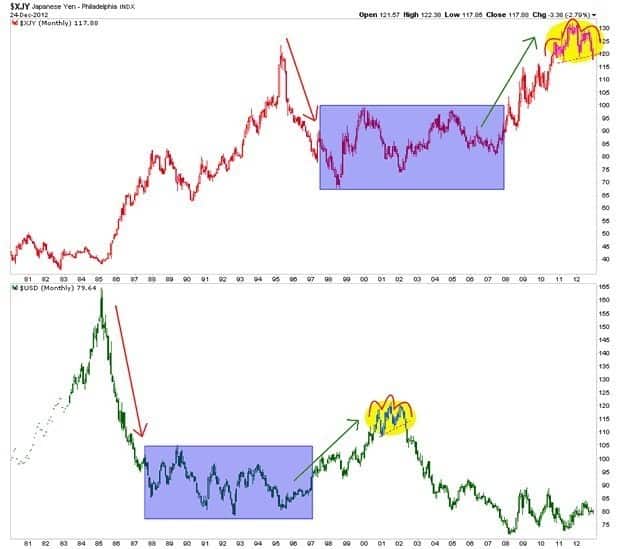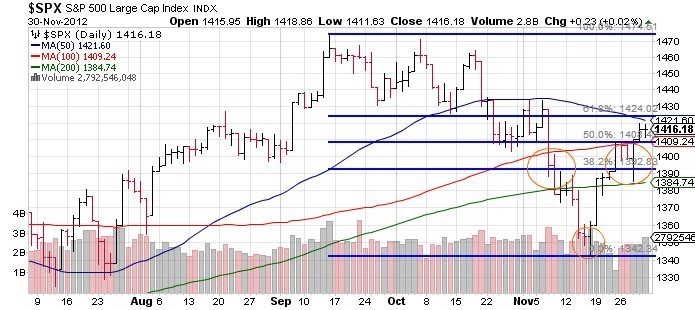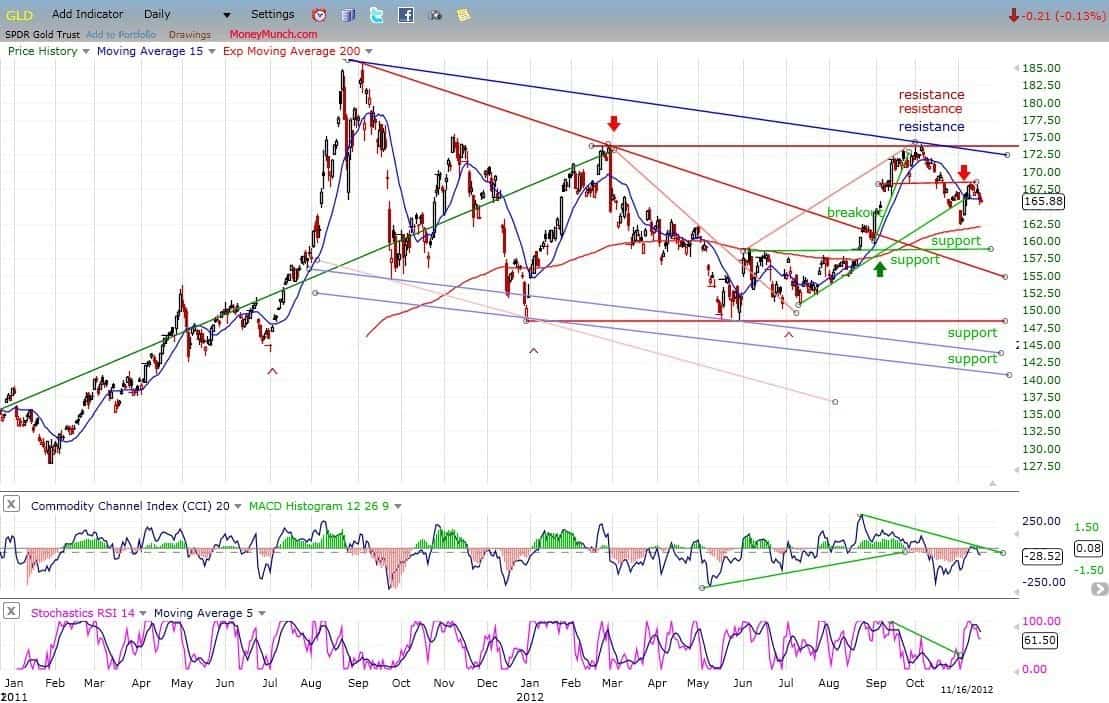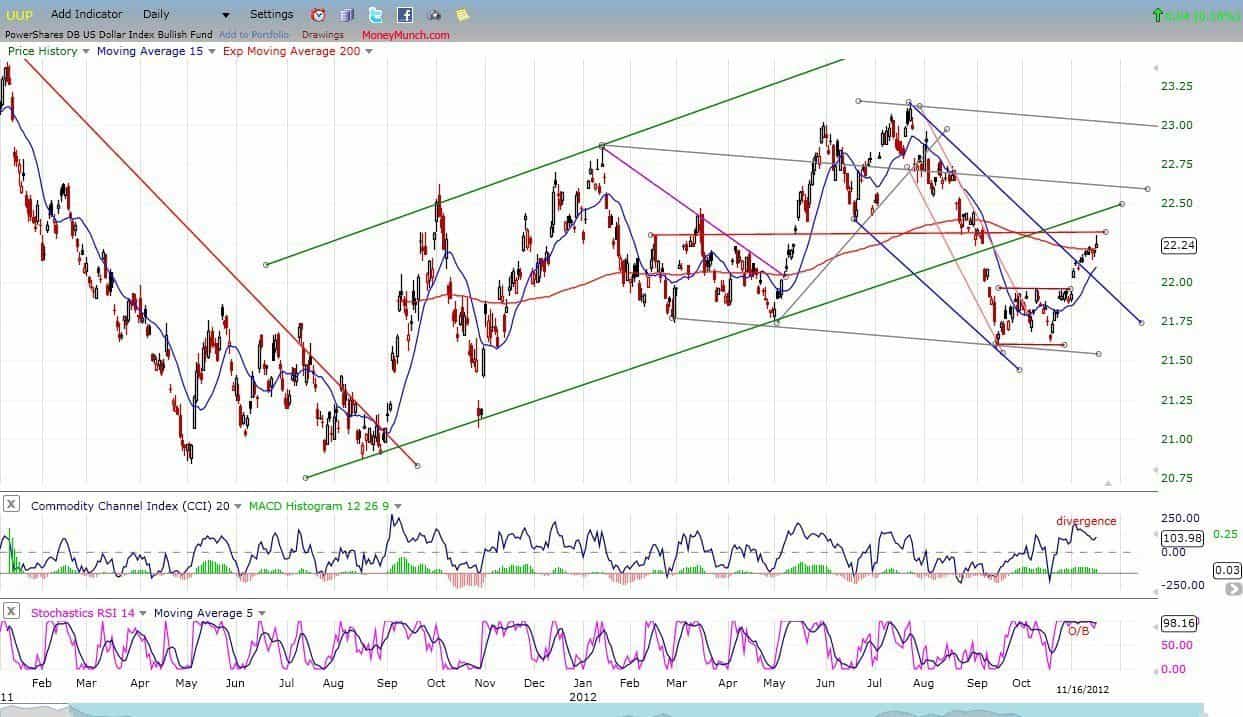Moving Avg-Exponential Indicator:
Conventional Interpretation: Price is above the moving average so the trend is up.
Trend: Market trend is UP.
Mov Avg 3 lines Indicator:
Note: In evaluating the short term, plot1 represents the fast moving average, and plot2 is the slow moving average. For the longer term analysis, plot2 is the fast moving average and plot3 is the slow moving average
Conventional Interpretation – Short Term: The market is bullish because the fast moving average is above the slow moving average.
Additional Analysis – Short Term: The market is EXTREMELY BULLISH. Everything in this indicator is pointing to higher prices: the fast average is above the slow average; the fast average is on an upward slope from the previous bar; the slow average is on an upward slope from the previous bar; and price is above the fast average and the slow average.
Conventional Interpretation – Long Term: The market is bullish because the fast moving average is above the slow moving average.
Additional Analysis – Long Term: The market is EXTREMELY BULLISH. Everything in this indicator is pointing to higher prices: the fast average is above the slow average; the fast average is on an upward slope from the previous bar; the slow average is on an upward slope from the previous bar; and price is above the fast average and the slow average.
Bollinger Bands Indicator:
Conventional Interpretation: The Bollinger Bands are indicating an overbought market. An overbought reading occurs when the close is nearer to the top band than the bottom band.
Additional Analysis: The market appears overbought, but may continue to become more overbought before reversing. Given that we closed at a 45 bar new high, the chance for further bullish momentum is greatly increased. Look for some price weakness before taking any bearish positions based on this indicator.
Volatility Indicator: Volatility is in a downtrend based on a 9 bar moving average.
Momentum Indicator:
Conventional Interpretation: Momentum (1000.11) is above zero, indicating an overbought market.
Additional Analysis: The long term trend, based on a 45 bar moving average, is UP. The short term trend, based on a 9 bar moving average, is UP. Momentum is indicating an overbought market, and appears to be slowing. A modest downturn is possible here.
Rate of change Indicator:
Conventional Interpretation: Rate of Change (7.69) is above zero, indicating an overbought market.
Additional Analysis: The long term trend, based on a 45 bar moving average, is UP. The short term trend, based on a 9 bar moving average, is UP. Rate of Change is indicating an overbought market, and appears to be slowing. A modest downturn is possible here.
Comm Channel Index Indicator:
Conventional Interpretation: CCI (170.27) recently crossed above the buy line into bullish territory, and is currently long. This long position should be liquidated when the CCI crosses back into the neutral center region.
Additional Analysis: CCI often misses the early part of a new move because of the large amount of time spent out of the market in the neutral region. Initiating signals when CCI crosses zero, rather than waiting for CCI to cross out of the neutral region can often help overcome this. Given this interpretation, CCI (170.27) is currently long. The current long position position will be reversed when the CCI crosses below zero. Adding bullish pressure the market just reached a 45 bar new high.
RSI Indicator:
Conventional Interpretation: RSI is in neutral territory. (RSI is at 66.70). This indicator issues buy signals when the RSI line dips below the bottom line into the oversold zone; a sell signal is generated when the RSI rises above the top line into the overbought zone.
Additional Analysis: RSI is somewhat overbought (RSI is at 66.70), but given the 45 bar new high here, greater overbought levels are likely.
MACD Indicator:
Conventional Interpretation: MACD is in bullish territory, but has not issued a signal here. MACD generates a signal when the FastMA crosses above or below the SlowMA.
Additional Analysis: The long term trend, based on a 45 bar moving average, is UP. The short term trend, based on a 9 bar moving average, is UP. MACD is in bullish territory. And, the market just put in a 45 bar new high here. Look for more new highs.
Open Interest Indicator: No open interest value in the database for this bar. Note: Open interest not available for all data types.
Volume Indicator:
Conventional Interpretation: The current new high is not accompanied by increasing volume, suggesting that the current move lacks broad participation. Look for a retracement soon.
Additional Analysis: The long term market trend, based on a 45 bar moving average, is UP. The short term market trend, based on a 5 bar moving average, is UP.The current new high is not accompanied by increasing volume, suggesting that the current move lacks broad participation and the market may be overbought. A retracement is possible here.
Stochastic – Fast Indicator:
Conventional Interpretation: The stochastic is in overbought territory (SlowK is at 96.91); this indicates a possible market drop is coming.
Additional Analysis: The long term trend is UP. The short term trend is UP. Even though the stochastic is signaling that the market is overbought, don’t be fooled looking for a top here because of this indicator. The stochastic indicator is only good at picking tops in a Bear Market (in which we are not). Exit long position only if some other indicator tells you to.
Stochastic – Slow Indicator:
Conventional Interpretation: The stochastic is in overbought territory (SlowK is at 94.33); this indicates a possible market drop is coming.
Additional Analysis: The long term trend is UP. The short term trend is UP. Even though the stochastic is signaling that the market is overbought, don’t be fooled looking for a top here because of this indicator. The stochastic indicator is only good at picking tops in a Bear Market (in which we are not). Exit long position only if some other indicator tells you to.
Swing Index Indicator:
Conventional Interpretation: The swing index is most often used to identify bars where the market is likely to change direction. A signal is generated when the swing index crosses zero. No signal has been generated here.
Additional Analysis: No additional interpretation.
Important: This commentary is designed solely as a training tool for the understanding of technical analysis of the financial markets. It is not designed to provide any investment or other professional advice.
Continue reading


